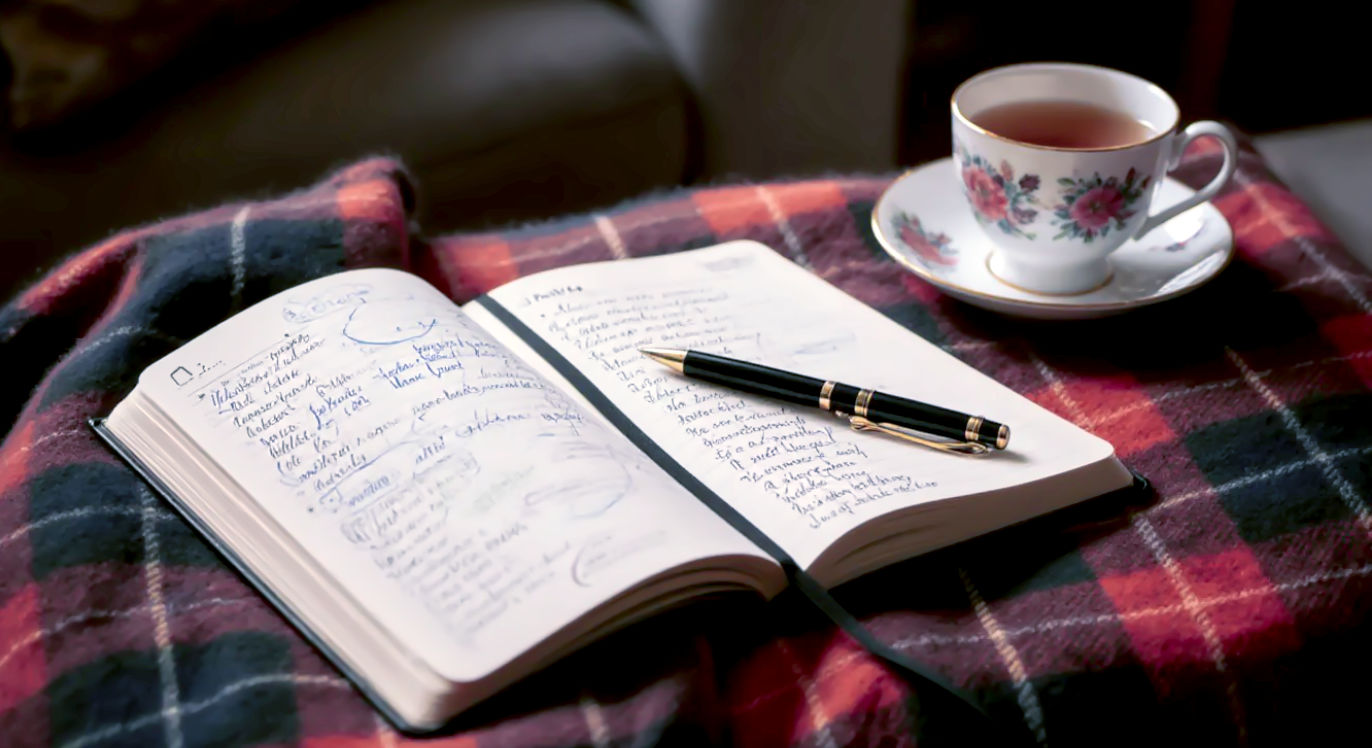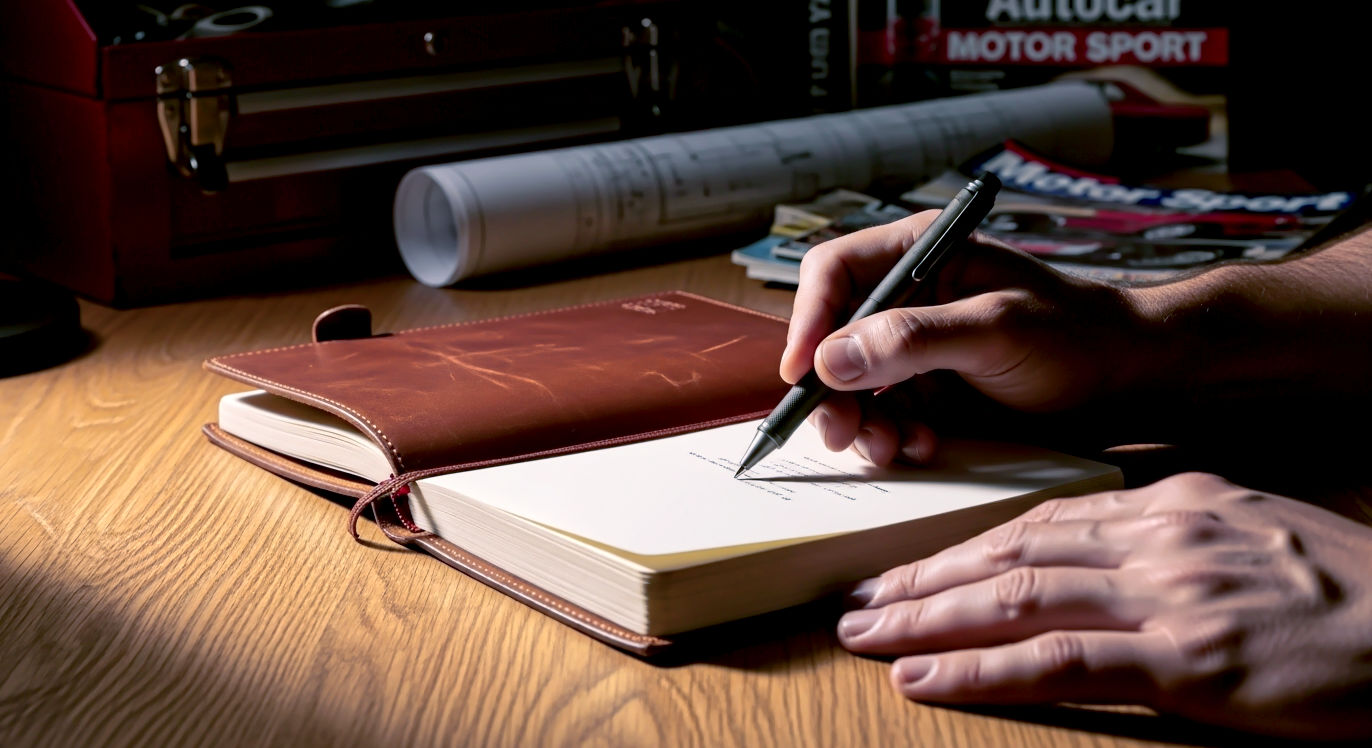Transform Your Mind: The Definitive British Guide to Journaling for Mental Health
Discover the power of journaling. Our definitive guide covers types, prompts, and science-backed tips to boost your mental well-being. Start today.

This post may contain affiliate links. If you make a purchase through these links, we may earn a commission at no additional cost to you.
Let’s be honest. Life in the UK, or anywhere, really, can feel like a bit of a slog. Your phone pings with work emails before you’ve even had a cuppa. The news is… well, the news. You’ve got a mental to-do list a mile long, from remembering to buy milk to worrying about that weird comment your boss made.
It’s called mental load, and we’re all carrying it. Our minds are noisy, crowded places.
So, what do we do? We often look for complicated fixes. We download mindfulness apps we forget to use. We dream of expensive wellness retreats. We tell ourselves we should “just cope,” thanks to that classic British stiff upper lip.
But what if the most powerful tool for calming your mind isn’t on an app store? What if it’s sitting in a drawer?
It’s a pen and a blank piece of paper.
We’re talking about journaling. And no, not the “Dear Diary, today I ate a biscuit” kind you might have kept as a kid.
We’re talking about journaling as a powerful, practical, and science-backed tool for managing your mental health. It’s a way to process the chaos, understand your feelings, and actively change your thought patterns. It’s like a private gym for your mind. And the best part? It’s free, it’s simple, and you can start right now.
This is your definitive guide to journaling for mental health. We’ll cover why it works, the different ways to do it, and how you can start today, even if you think you’re a “terrible writer” or “don’t have time.”
What is Journaling for Mental Health, Really? (Beyond the Teenage Diary)
First, let’s get one thing straight. Journaling for mental health isn’t about creating a perfect, beautiful log of your life. It’s not for Instagram. It’s not for anyone else to read.
It is a private, judgment-free space for your brain to dump its thoughts, untangle its knots, and make sense of the world.
It’s Not a Performance
Many of us (especially we Brits) get put off because we think journaling has to be… well, good. We think it needs to be clever, or insightful, or have perfect grammar.
Rubbish.
Your journal is not being marked by your old English teacher. It’s a tool, not a performance. It can be messy. It can be full of spelling mistakes. It can be one angry sentence or ten pages of rambling. It doesn’t matter.
A Private Space for Your Brain
Think of your mind like a busy room full of shouting people. You can’t hear yourself think. Journaling is like asking everyone to leave the room, one by one.
You take the jumbled, noisy thoughts from your head—the worries, the fears, the anger, the brilliant ideas—and you put them onto the page. Once they’re on the page, they stop shouting so loudly. You can look at them, one by one, and think, “Ah, that’s what’s bothering me.”
The Core Idea: Expressive Writing
At its heart, journaling for mental health is based on a concept called “expressive writing.” This was popularised by a psychologist named Dr. James Pennebaker.
His research found something amazing. When people wrote about their deepest, most difficult thoughts and feelings for just 15-20 minutes a day, their mental and physical health improved.
Why? Because they were turning their messy, scary feelings into a structured story. They were processing their emotions, not just stewing in them.
The Science: Why Does Writing Things Down Make Us Feel Better?
This isn’t just fluffy wellness talk. There’s real science behind why scribbling in a notebook helps.

Taming the Amygdala (The Brain’s Alarm System)
You have a part of your brain called the amygdala. You can think of it as your brain’s alarm bell. When you’re stressed, anxious, or scared, this alarm bell starts ringing like mad. It’s the “fight or flight” centre.
When you’re stuck in your head, that alarm just keeps ringing.
But studies using brain scans show that when you start to write about your feelings, you use a different part of your brain: the prefrontal cortex. This is the “thinking” part of your brain, right behind your forehead. It’s like the brain’s sensible manager.
When the manager (prefrontal cortex) kicks in, it sends a message to the alarm bell (amygdala) saying, “Alright, mate, I’ve got this. Calm down.”
In short: writing about feelings calms your brain’s emotional alarm.
Processing, Not Just Ruminating
Ever had a worry that just goes round and round in your head, like a song stuck on repeat? That’s rumination. You’re not solving the problem; you’re just re-living the bad feeling.
Journaling breaks this cycle.
- Rumination (in your head): “I can’t believe I said that. I’m such an idiot. They all hate me. I’m so stupid. I can’t believe I said that.” (Repeat)
- Processing (on paper): “I’m feeling really embarrassed about what I said in the meeting. I’m worried people think I’m silly. But, realistically, Sarah laughed, and Dave even agreed with part of my point. Maybe it wasn’t so bad. Next time, I’ll just try to slow down before I speak.”
See the difference? Writing it down forces you to put the thought into a logical order. You turn a vague feeling into a specific problem you can start to solve.
The ‘Name It to Tame It’ Principle
This is a simple phrase used by mindfulness experts. When you can put a label on a feeling—”I am feeling angry,” “I am feeling jealous,” “I am feeling overwhelmed“—it instantly gives you power over it.
Journaling is the best way to do this. You’re forced to find the words, and in finding them, you “name” the feeling. And once it has a name, it’s not a big, scary monster anymore. It’s just… anger. And you can deal with anger.
Long-Term Brain Benefits
The more you practice this, the better your brain gets at it. You’re building a new mental habit. Over time, you strengthen the connection between the “thinking” part of your brain and the “feeling” part. This can make you more resilient to stress in the long run.
The Big Five: Proven Mental Health Benefits of Journaling
Okay, so the science is cool. But what will you actually get out of it? Here are the top, research-backed benefits.
1. Easing Anxiety and Managing Stress
This is the big one. Anxiety is often caused by “what if?” thoughts about the future. Your journal is the perfect place to “catch” these thoughts.
- It gets them out of your head: A page full of your worries is better than a head full of them.
- It gives you perspective: When you write down “What if I get fired?” you can then ask, “Okay, what’s the evidence for that? My boss said I did a good job last week.” You can challenge your own anxious thoughts.
- It helps you spot triggers: After a few weeks, you might look back and see a pattern. “Wow, I always feel really anxious on Sunday nights.” Now you have information you can act on.
2. Lifting the Fog of Depression and Low Mood
When you’re feeling low or depressed, your thoughts can become very negative and critical. Journaling can be a powerful tool to fight back, especially methods recommended by the NHS and mental health charities like Mind.
- It challenges negative self-talk: A common technique from Cognitive Behavioural Therapy (CBT) is to catch, check, and change negative thoughts. A journal is the perfect place to do this (more on that later).
- It reminds you of the good: Depression can make your brain filter out all the good stuff. A gratitude journal, where you simply write down 3-5 things you’re thankful for, forces your brain to look for the positives, no matter how small (“The coffee tasted good this morning,” “My cat sat on my lap”).
3. Processing Trauma and Difficult Events
This is where expressive writing, like Dr. Pennebaker’s work, is most powerful. When we go through something difficult—a break-up, a bereavement, a redundancy—we often try to “just get over it.”
But the feelings don’t just go away. Journaling gives you a safe, private way to make sense of what happened. It lets you write your own story of the event, in your own time, without anyone else’s opinions.
(A quick note: If you’re dealing with serious trauma, it’s always best to work with a qualified therapist. Journaling can be a fantastic support to that work.)
4. Boosting Self-Awareness and Emotional Intelligence
Do you ever just feel “bad” but don’t know why? Or snap at your partner and not understand what set you off?
Journaling is like holding up a mirror to your own mind. By writing down your thoughts, you start to see why you feel what you feel.
- “I snapped at my partner… Oh, I see. I was actually angry about that email from my sister 10 minutes earlier.”
This is emotional intelligence. The better you understand your own feelings, the better you can manage them and understand other people’s, too.
5. Improving Sleep and Physical Health
This one might surprise you. But think about it: what’s the main reason you can’t get to sleep? That spinning, ruminating mind.
Many people find that doing a “brain dump” for 10 minutes before bed is a game-changer. You write down:
- Everything you’re worried about.
- Everything you need to do tomorrow.
You’re effectively “closing the tabs” in your brain and parking the thoughts on the page. You’ve told your brain, “It’s written down. You don’t need to keep reminding me.”
Studies have also linked regular journaling to a stronger immune system and lower blood pressure. When your mind is less stressed, your body follows.
Finding Your Style: A Guide to the Most Effective Journaling Methods
There is no “right” way to journal. The best method is the one you’ll actually do. Here are some of the most popular and effective styles.

The “Get It All Out” Method: Stream of Consciousness
This is the simplest form of journaling. It’s also called a “brain dump.”
- How to do it: You set a timer (5, 10, or 20 minutes). You pick up your pen. You write. You do not stop writing until the timer goes off.
- What to write: Anything. Literally, anything that pops into your head. “I’m so tired today I can’t think what to write, the kitchen tap is dripping, I must remember to buy bananas, I wonder if Sarah was annoyed with me yesterday, this pen is running out…”
- Why it works: It clears the mental clutter. It’s like hoovering your brain. You don’t try to solve anything; you just get it out. It’s brilliant for when you feel overwhelmed.
The “Find the Good” Method: Gratitude Journaling
This is simple, fast, and incredibly powerful for low moods.
- How to do it: Every day (perhaps before bed), write down 3-5 things you are genuinely grateful for.
- What to write: They must be specific.
- Don’t write: “My family.”
- Do write: “The way my partner made me a cup of tea without me asking.”
- Don’t write: “My job.”
- Do write: “That one nice email I got from a client.”
- Why it works: It trains your brain to scan for positives instead of negatives. It’s like a mental workout for happiness.
The “Fix Your Thoughts” Method: Cognitive Behavioural Therapy (CBT) Journaling
This is a more structured approach, straight from therapy. It’s fantastic for anxiety and negative self-talk. The most common tool is a “Thought Record.”
It sounds complicated, but it’s just a table.
- How to do it: When you feel a strong negative emotion, you draw a few columns in your journal.
- Situation: What just happened? (e.g., “My boss sent me a one-word email: ‘Urgent.'”)
- Feeling(s): How do I feel? (e.g., “Anxious (9/10), Scared (7/10).”)
- Automatic Thought: What’s the first thought that popped into my head? (e.g., “I’m in trouble. I’ve done something wrong. I’m going to be fired.”)
- Evidence For: What facts support this thought? (e.g., “Well, the email did say ‘Urgent.'”)
- Evidence Against: What facts don’t support this thought? (e.g., “He sends emails like that all the time. I just finished a big project successfully. He’s probably just busy.”)
- New, Balanced Thought: What’s a more realistic way to see this? (e.g., “He’s probably just busy and needs something quickly. It’s unlikely I’m in trouble. I’ll just ask him what he needs.”)
- New Feeling(s): How do I feel now? (e.g., “Anxious (3/10), Curious (5/10).”)
- Why it works: It teaches you that your thoughts are not facts. You learn to catch your automatic negative thoughts and challenge them with evidence, like a detective.
The “Tell Your Story” Method: Expressive Writing
This is the Dr. Pennebaker method. It’s best for processing a specific, difficult event or feeling.
- How to do it: You set a timer for 20 minutes. You write about a challenging event or feeling. The key is to explore both the event and your deepest emotions connected to it.
- What to write: “The redundancy was awful. I felt…” “The break-up is still hurting. The hardest part is…”
- Why it works: It helps you build a narrative and make sense of the chaos. You’re creating a coherent story from a messy experience, which helps your brain “file it away” properly.
The “Organise Your Mind” Method: The Bullet Journal (BuJo)
You might have seen these on social media—they look beautiful and complicated. But at its heart, the Bullet Journal (invented by Ryder Carroll) is a simple system for mental health.
- How to do it: It’s a “to-do list, diary, and mindfulness tracker all in one.” You use “bullets” (dots, circles, dashes) to log tasks, events, and notes.
- Why it works for mental health:
- It tames overwhelm: You get all your tasks, appointments, and ideas into one place.
- It’s mindful: The act of setting up your own planner on paper is a slow, mindful, analogue activity.
- You can add trackers: Many people add a “mood tracker” or “habit tracker” (e.g., “Did I drink water?” “Did I go for a walk?”). This gives you real data on what makes you feel good.
The “Quick Win” Method: The 5-Minute Journal
This is a branded journal, but you can do it in any notebook. It’s perfect for people who say they “don’t have time.”
- How to do it (In the Morning):
- I am grateful for… (List 3 things)
- What would make today great? (List 3 things)
- Daily affirmations. (e.g., “I am capable.”)
- How to do it (In the Evening):
- 3 amazing things that happened today.
- How could I have made today even better?
- Why it works: It’s fast, structured, and forces you to start and end your day with positive intention and reflection.
How to Start Journaling Today: A No-Fuss Guide for Beginners
This is the most important part. Don’t just read this article. Do it. Here’s how.
Step 1: Choose Your Tools (Pen and Paper vs. Digital)
This can be a sticking point. Keep it simple.
The Case for Analogue: Pen and Paper
- It’s slower: This is a good thing. The physical act of writing by hand connects to your brain differently than typing. It forces you to slow down your thoughts.
- It’s private: A notebook doesn’t have a password that can be hacked. It’s offline.
- It’s distraction-free: A notebook won’t ping you with a notification from Instagram.
What to use? Any. A fancy Moleskine is lovely. A 50p notebook from Tesco is also lovely. The back of an old receipt book works. The tool does not matter. Use a pen that you enjoy writing with. That’s it.
The Case for Digital: Journaling Apps
- It’s convenient: You always have your phone with you.
- It’s private (in a different way): You can password-protect apps.
- It’s searchable: You can easily look back for keywords.
- It can prompt you: Apps like Day One, Stoic, or Reflectly can send you reminders and give you prompts.
The verdict? Most experts agree that pen and paper is slightly better for the “brain-calming” benefits because it’s slower and more mindful. But the best tool is the one you will use. If you know you’ll use an app, use an app.
Step 2: Forget the “Rules”
We’ve said it before, but it’s the biggest barrier. Let go of perfection.
- You don’t have to write every day.
- You don’t have to write pages and pages.
- You don’t have to write in full sentences. Bullet points are fine.
- You don’t have to be “deep.” You can write about your lunch.
- You don’t have to use a “method.” You can just scrawl.
Step 3: Find Your “When and Where” (The ‘Habit Stack’)
The easiest way to build a new habit is to “stack” it onto one you already have.
- Stack it with your morning coffee. Before you check your phone, write one page.
- Stack it with your commute. (If you’re not driving!) Write on the train or bus.
- Stack it with getting into bed. Put your journal and pen on your bedside table. Write for 5 minutes before you turn the light out.
Make it easy. Leave the journal where you can see it. This is called “triggering” the habit.
Step 4: Just Start Writing (Even for Two Minutes)
Don’t set a huge goal. “I’m going to write for an hour” will fail. Set a tiny goal. “I will write for two minutes.” Or “I will write one sentence.”
Anyone can do that. And often, once you start, you’ll find you want to keep going.
“But I Don’t Know What to Write!” (70 Prompts to Get You Started)
The blank page is scary. So don’t start with one. Use a prompt. Think of these as conversation starters with yourself.

15 Prompts for When You Feel Anxious or Overwhelmed
- What’s the one thing that’s taking up most of my brain-space right now?
- Write down every single “what if” thought that’s bothering me.
- What’s a fact-based reason this worry might not come true?
- If my best friend felt this way, what would I tell them?
- What are 5 things I can see around me right now? (A grounding exercise).
- What is one thing I can control in this situation?
- What is one thing I cannot control?
- A list of things that make me feel calm.
- “Brain dump”: Just write a list of every single thing on my to-do list.
- What’s the smallest possible step I could take to feel 1% better?
- Describe this anxious feeling as if it were a monster or a character. What does it look like?
- What has helped me get through this feeling in the past?
- If this anxiety was a physical object, what would I do with it? (Throw it, put it in a box, etc.)
- What would the 80-year-old version of me say about this worry?
- What am I really afraid of, underneath this anxiety?
15 Prompts for When You Feel Sad or Stuck
- It’s okay to feel this way. What am I feeling, in one word?
- What small thing could I do today that would feel like a tiny “win”?
- Write about a time I felt truly happy. What was I doing? Who was I with?
- What’s a piece of music that always makes me feel something? Describe it.
- Write a letter to the “sad” part of me. What does it need to hear?
- What is one thing I used to love doing that I’ve stopped?
- What am I really missing in my life right now?
- I am feeling… (Just finish the sentence, over and over).
- Describe a perfect, gentle day. What would it involve?
- What’s one negative thought I keep having? What’s the opposite of that thought?
- A list of 3 things that are, objectively, “okay” in my life right now.
- What’s one thing I could let go of (a grudge, a task) to feel lighter?
- Write about a simple pleasure. (A hot shower, a good biscuit, clean sheets).
- What is this sadness trying to tell me?
- If I couldn’t fail, what’s one thing I would do?
15 Prompts for Self-Discovery and Growth
- When do I feel most “myself”?
- What’s a “compliment” I would give myself today?
- What’s a boundary I need to set? (With work, with a person).
- If I had a totally free Saturday, what would I actually want to do?
- What am I curious about right now?
- What’s a mistake I made that actually taught me something important?
- List 10 things I’m good at (big or small, e.g., “making a good brew”).
- What are my “core values”? (e.g., Honesty, kindness, creativity).
- How am I different today than I was a year ago?
- What’s a quality I admire in someone else? How could I practice that?
- Write a letter to my 16-year-old self.
- What does “success” really mean to me (not to anyone else)?
- What’s one small act of kindness I could do today?
- What advice would I give to a 10-year-younger version of me?
- How do I want to be remembered by others?
15 Prompts for Gratitude and Positivity
- What’s one simple thing that made me smile today?
- Who is one person who has helped me recently?
- What’s a part of my body I’m grateful for and why? (e.g., “My legs, for carrying me”).
- What’s a piece of technology that makes my life easier?
- What’s one thing in nature I saw today? (A cloud, a plant, a pigeon).
- What’s a food I’m looking forward to eating?
- What’s a skill I have that I’m proud of?
- What’s a comfortable item of clothing I love?
- What’s a song I’m grateful for?
- Who is someone in my life I can always be myself with?
- What’s a memory I’m grateful for?
- What’s one thing I’m taking for granted?
- What’s something beautiful I saw today?
- What’s one “failure” I’m actually grateful for?
- What’s something about my home I’m grateful for?
10 Quick Prompts for a Busy Day
- One word to describe today.
- My main “win” today was…
- My main “challenge” today was…
- I’m letting go of…
- I’m looking forward to…
- Today I felt…
- I need to remember to…
- One thing I learned today.
- I’m grateful for…
- My intention for tomorrow is…
Common Journaling Myths and Hurdles (And How to Beat Them)
Even with all this, it’s easy to get stuck. Here are the main worries and how to get past them.
Myth 1: “I’m not a ‘writer’ / My spelling is awful.”
The Fix: Good! This isn’t writing; it’s thinking. Your journal is the one place you never have to worry about spelling, punctuation, or making sense. It’s for your eyes only. If it helps, write “This is just for me” at the top of the first page.
Myth 2: “I don’t have time.”
The Fix: This is the most common one. But you do have five minutes. You have two minutes. You have 30 seconds. You spend more time than that scrolling social media or waiting for the kettle to boil. Use the Two-Minute Rule. If it takes less than two minutes, do it now. Or try the 5-Minute Journal method. A tiny bit is infinitely better than nothing.
Myth 3: “It feels self-indulgent or cringey.”
The Fix: This is that “stiff upper lip” talking. Is going to the gym “self-indulgent”? Is brushing your teeth? No. They are basic maintenance. Think of journaling as mental maintenance. It’s not “cringey” to look after your own mind; it’s the most responsible, adult thing you can do. It makes you a better partner, friend, and colleague.
Myth 4: “What if someone reads it?” (The Privacy Question)
The Fix: This is a fair concern.
- Analogue: Keep it somewhere simple. It doesn’t have to be a locked diary. It could be a boring-looking notebook you keep in your work bag or on your bookshelf.
- Digital: Use an app with a strong password or biometric (fingerprint/face) lock.
- The “Burn Book”: Some people write on a loose piece of paper and then, when they’re done processing, they tear it up or (safely!) burn it. The benefit comes from the act of writing, not from re-reading it.
Myth 5: “I tried it once, and it didn’t work.”
The Fix: That’s like saying, “I went to the gym once, and I’m not fit.” Journaling is a practice, not a magic pill. It’s a skill you build over time. The benefits are cumulative. Maybe you didn’t find the right style. If you hated stream-of-consciousness, try a structured gratitude list. If a gratitude list felt cheesy, try a practical Bullet Journal.
Don’t give up after one try. Give it a gentle, consistent go for two weeks.
A Note for the Chaps: Why Journaling Isn’t Just “a Girl Thing”
Let’s be blunt. In the UK, there’s still a massive stigma around men and mental health. We’re told to “man up” and “get on with it.” The idea of writing about feelings can seem soft or self-indulgent.

This is a huge mistake.
Breaking Down the British “Stiff Upper Lip”
That “stiff upper lip” is a recipe for anxiety, stress, and anger that has nowhere to go. Journaling isn’t “wallowing.” It’s the opposite. It’s active problem-solving.
A Tool for Problem-Solving
Think of your journal as a workbench. When a problem is in your head, it’s a jumbled mess. When you write it down, you’ve laid all the parts out on the bench. You can see them clearly. You can see what’s broken. You can figure out which tool to use.
It’s a space to be strategic about your life.
- “This situation at work is a mess. What are my options? 1… 2… 3…”
- “I keep getting angry. Why? Ah, it’s because I’m not sleeping.”
- “What are my goals for the next 6 months? How do I get there?”
Famous Men Who Journaled
This isn’t a new, ‘woke’ trend. This is a classic tool for high-performers. Marcus Aurelius, the Roman Emperor, kept a journal (it’s now the famous book Meditations). Oscar Wilde kept one. Winston Churchill was a prolific writer about his own “black dog” (depression).
It’s a tool for clarity, strategy, and resilience. Full stop.
Taking It Further: Journaling as a Partner to Therapy
It’s vital to say this: journaling is not a replacement for professional help.
If you are seriously struggling with your mental health, please speak to your GP or contact a charity like Mind or the Samaritans.
But journaling is an incredible partner to therapy.
- It makes therapy more effective: You’ll go into your sessions with a clearer idea of what you want to talk about.
- It helps you practice: Your therapist might give you tools (like a CBT thought record). Your journal is the place you practice using them.
- It helps you see progress: On a bad day, you can look back at your journal from six months ago and think, “Wow. I’m actually handling things so much better now.”
The Final Word: Your Mind, Transformed
So, there you have it.
Journaling isn’t a magical cure. It won’t make all your problems disappear.
What it will do is give you a space to breathe. A space to understand yourself. A space to be honest. It’s a simple, radical act of self-care that costs almost nothing.
In a world that is constantly shouting at you, your journal is a quiet room where you can finally hear yourself think.
It’s a Practice, Not a Performance
Don’t aim for a perfect journal. Aim for a used one. Aim for messy, honest, and finished. Aim for two minutes.
Your journey to a clearer, calmer mind doesn’t start with a meditation retreat or a fancy app.
It starts with one blank page and one simple sentence.
Go on. Grab a pen.
Further Reading & Resources
For more information and support, these highly-respected resources are a great place to start:
- Mind: The leading mental health charity in England and Wales. They have fantastic, practical resources on all aspects of mental well-being, including mindfulness and “five ways to well-being.”
- NHS – Mindfulness: The official NHS page explaining mindfulness, which shares many principles with journaling.
- Samaritans: If you are struggling to cope and need to talk to someone, you can call them for free on 116 123, any time.
- The Center for Journal Therapy: An international resource with lots of information on the different methods of therapeutic journaling.
- James W. Pennebaker’s Research: For those interested in the deep science, look up his work on “expressive writing” and its proven health benefits.



